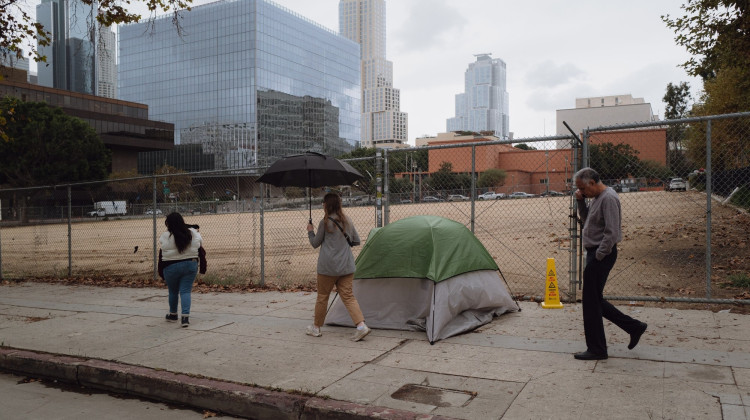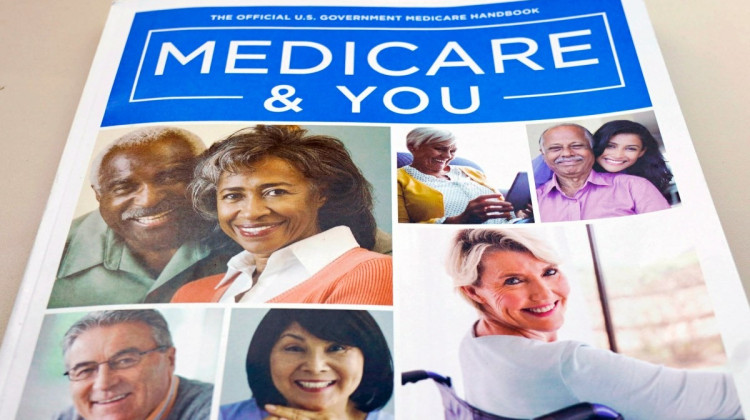
The Indiana Department of Health added 516 new deaths to its total in the last week.
(Jeanie Lindsay/IPB News)Some Indiana school districts no longer need to do contact tracing. The state’s COVID-19 cases have continued to slow as it reaches 1.6 million confirmed cases. And the state surpassed 20,000 dead, reporting its most recent 1,000 in just two weeks.
THE DATA
Last Monday, Indiana officially surpassed 20,000 dead – adding its most recent 1,000 deaths in just two weeks.
State health officials say there are an additional 712 suspected COVID-19 deaths – where a test wasn’t administered but health care professionals believe the person had the virus.
In the last week, the Indiana Department of Health added 516 new deaths to its total.
Indiana also surpassed 1.6 million confirmed COVID-19 cases Friday, but continued to see positive signs of slowing down. The state reported nearly 20 percent fewer cases last week compared to the week before.
Parke, Lake, Cass and La Porte counties all saw cases drop by more than 20 percent. Marion and Hendricks counties were close behind. But two counties – Scott and Franklin – saw their cases grow by more than 50 percent.
In November, the state averaged 2,707.2 new cases per day. But in December, when the strain was making its way through the U.S., that grew to 5,193.9. For January so far, the state is averaging 12,451.6 cases per day.
Another positive sign: Indiana’s COVID-19 hospital census has dropped below 3,000 for the first time in more than a month.
What the latest COVID-19 data means for you
Nearly two years into the COVID-19 pandemic, doctors and researchers know a lot more about how to deal with COVID-19 and what it takes to respond: vaccines, testing, treatments and public health measures.
But there are many aspects of living through this pandemic that can be confusing, especially as new variants emerge and public health guidance changes. There is so much data related to COVID-19 available that it can be hard to make sense of it all.
IU Health shares update on impact of COVID-19 at its hospitals
Indiana’s largest hospital system says COVID-19 cases continue to be high across the network, but numbers are improving slightly.
COVID-19 hospitalizations are at 567 across Indiana University Health's 16 facilities. That number is down from a peak of 640 cases. Dr. Chris Weaver, IU Health chief clinical officer, said the vaccine continues to show effectiveness in keeping people out of intensive care.
“We see very few cases of the total that are fully vaccinated with boosters,” Weaver said.
THE HEADLINES
Indiana schools with mask mandates are no longer required to do contact tracing
Some K-12 schools in Indiana will no longer need to conduct contact tracing and report those efforts to the state’s health department.
The Indiana Department of Health previously required all schools to report positive cases and close contacts to the state. But schools with mask mandates in place now only have to report the positive cases, IDOH spokeswoman Megan Wade-Taxter said in an email.
Instead of conducting contact tracing on the individual level, those schools can simply notify parents about positive cases in the classroom.
Join the conversation and sign up for the Indiana Two-Way. Text "Indiana" to 73224. Your comments and questions in response to our weekly text help us find the answers you need on COVID-19 and other statewide issues.
All IN: Omicron's impact on Indiana schools
The omicron variant caused a record number of cases among students and staff in school districts across Indiana.
All IN caught up on how leaders are responding, and what health experts say needs to happen next.
Indiana unemployment rate hits historic low amid increasingly tight labor market
Indiana’s unemployment rate may have reached a historic low, reaching just 2.7 percent in December. More workers found employment, but the overall labor force is continuing a months-long downward slide.
It’s still preliminary data, but it shows Indiana with the fewest number of workers having trouble finding jobs since the federal government began tracking state levels in the 1970s. But lately there’s simply fewer people reporting availability to work each month.
Andrew Butters, economics professor at Indiana University, said those two things together indicate an even tighter labor market. He said research seems to show older workers may be retiring sooner and others are on the sidelines grappling with issues like child care.
Indiana has historic low unemployment, but is that always a good thing?
Low unemployment rates are generally a good thing. It means almost anyone looking for work can find a job. But with 38 counties at 1 percent or less unemployment rates (not factoring in seasonal adjustment), the state may be entering unusual territory where unemployment is so low it can have some unintended consequences.
We talk a lot about it being a tight labor market, these rates mean it’s super-duper tight. Basically, most anyone applying for a new job right now already has one. That means employers are having a harder time filling jobs to grow their businesses, or even just run them at their usual capacity.
Contact Lauren at lchapman@wfyi.org or follow her on Twitter at @laurenechapman_.
 DONATE
DONATE








 Support WFYI. We can't do it without you.
Support WFYI. We can't do it without you.